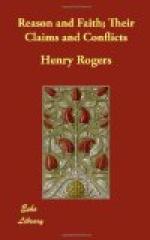Without entering into the many different sources of argument for the existence of a Supreme Intelligence, we shall only refer to that proof on which all theists, savage and civilised, in some form or other, rely—the traces of an ‘eternal power and godhead’ in the visible creation. The argument depends on a principle which, whatever may be its metaphysical history or origin, is one which man perpetually recognises, which every act of his own consciousness verifies, which he applies fearlessly to every phenomenon, known or unknown; and it is this,—That every effect has a cause (though he knows nothing of their connexion), and that effects which bear marks of design have a designing cause. This principle is so familiar that if he were to affect to doubt it in any practical case in human life, he would only be laughed at as a fool, or pitied as insane. The evidence, then, which substantiates the greatest and first of truths mainly depends on a principle perfectly familiar and perfectly recognised. Man can estimate the nature of that evidence; and the amount of it, in this instance, he sees to be as vast as the sum of created objects;—nay, far more, for it is as vast as the sum of their relations. So that if (as is apt to be the case) the difficulties of realising this tremendous truth are in proportion to the extent of knowledge and the powers of reflection, the evidence we can perfectly appreciate is cumulative in an equal or still higher proportion. Obvious as are the marks of design in each individual object, the sum of proof is not merely the sum of such indications, but that sum infinitely multiplied by the relations established and preserved amongst all these objects; by the adjustment which harmonises them all into one system, and impresses on all the parts of the universe a palpable order and subordination. While even in a single part of an organised being (as a hand or an eye) the traces of design are not to be mistaken, these are indefinitely multiplied by similar proofs of contrivance in the many individual organs of one such being—as of an entire animal or vegetable. These are yet to be multiplied by the harmonious relations which are established of mutual proportion and subserviency amongst all the organs of any one such being: And as many beings even of that one species or class as there are, so many multiples are there of the same proofs. Similar indications yield similar proofs of design in each individual part, and in the whole individual of all the individuals of every other class of beings; and this sum of proof is again to be multiplied by the proofs of design in the adjustment and mutual dependence and subordination of each of these classes of organised beings to every other, and to all; of the vegetable to the animal—–of the lower animal to the higher. Their magnitudes, numbers, physical force, faculties, functions, duration of life, rates of multiplication and development, sources of subsistence, must all have been determined




